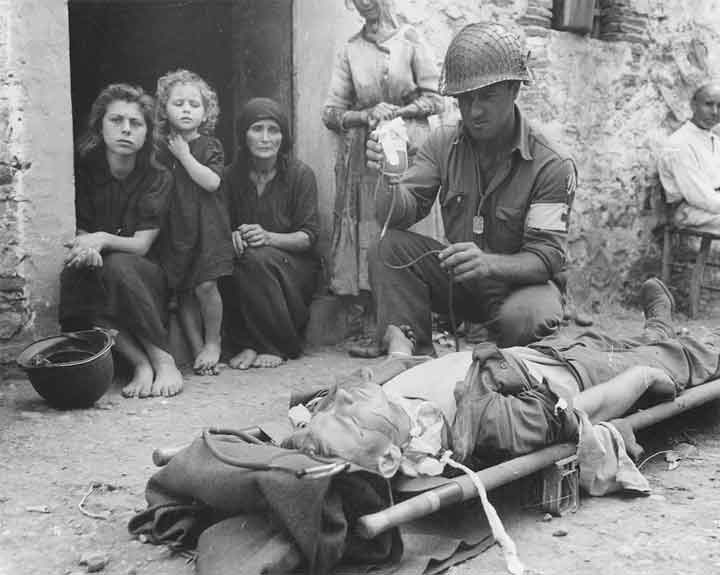July 1943 Operation Husky- The Invasion of Sicily

Wounded American
Following their successful campaign in North Africa, the Allied forces shifted their focus to Sicily. The objective was to secure Sicily and potentially compel Italy to withdraw from the conflict. The operation was designated as Operation Husky, commencing on the night of July 9-10.The invasion commenced with paratroop landings. While many paratroopers failed to reach their designated objectives, their presence alone caused panic among the defenders. In the early morning of the 10th, naval landings commenced on 26 different beaches. By the evening of the 10th, the Allies had successfully landed six divisions and established control of their beachhead.
Despite a valiant defense, the German and Italian forces were gradually overwhelmed by the superior Allied forces. On August 18th, the German and Italian forces completed their withdrawal from Sicily. .
Following the successful conclusion of the North African campaign, Sicily emerged as the logical next target for the Allied forces. The primary objective was to compel Italian surrender by capturing the island. Additionally, the invasion would facilitate the expulsion of German aircraft from the Mediterranean, thereby opening up the sea for unrestricted Allied transport.
General Dwight D. Eisenhower, who had commanded Allied forces in North Africa, was appointed overall commander for the invasion. His British Deputy General, Alexander, would lead British forces, while General George S. Patton would command American forces.
The invasion commenced with an airborne assault on the night of the 9th-10th. The US 82nd Airborne led the assault for American forces, while the British 1st Airborne led British troops. The high winds posed significant challenges, resulting in the majority of American paratroopers being dispersed from their intended targets. Furthermore, only 12 of 147 British gliders achieved their objectives. Despite these setbacks, the airborne assault, while not achieving its original objectives, effectively disrupted the morale of the Italian and German defenders, ultimately leading to their recognition as a success.
In the early morning of the tenth landing along the beaches, the Allied forces commenced their assault. They landed on 26 beaches spanning a 105-mile front between the towns of Licata and Cassibile. Despite the formidable high winds that posed a challenge to the landing, the Allied troops swiftly established their beachheads. Numerous Italian and German counterattacks were effectively repulsed, often aided by the naval gunfire from offshore vessels. By the conclusion of the day, the port of Licata had fallen under Allied control, and American and British forces swiftly disembarked.
The bombing campaign conducted the preceding week had decimated a substantial portion of the Italian and German air assets, leaving them with limited resistance capabilities. Notably, they were unable to prevent the sinking of the LST-313, the Minesweeper Sentinel, and the destroyer USS Maddox.
The Allied forces, rapidly gaining overwhelming numerical and equipment superiority over the Italians and Germans, steadily advanced across the island. With command of the sea, they were able to execute a strategic maneuver, landing troops behind enemy lines and advancing rapidly. On July 22nd, American forces successfully entered Palermo.
The final major Axis defense line encircled Mount Etana. The Germans held this position for a span of seven days before being effectively pushed back by Allied forces. On August 16th, American forces entered Messina. Simultaneously, the Germans had made the decision to withdraw all their forces to Italy. This withdrawal commenced on August 11th and was completed by August 17th. Regrettably, the Allies were unable to halt the orderly withdrawal of the German and Italian forces.
The United States Army suffered a loss of 2,237 killed or missing, 5,946 wounded, and 598 captured. The British suffered a loss of 2,062 killed or missing, 7,137 wounded, and 2,644 captured. The Canadian forces suffered an additional loss of 562 killed, 1,684 wounded, and 84 captured. Additionally, the United States Navy and Air Force suffered losses. The German forces suffered a loss of 4,325 captured, 4,583 missing, 5,532 captured, and 13,500 wounded. The Italian forces suffered a loss of 4,678 killed, 36,072 missing, 32,500 wounded, and 116,681 captured.
The operations were a complete victory for the Allied forces.
 >
>